

A Pattern Language. A Pattern Language: Towns, Buildings, Construction is a 1977 book on architecture, urban design, and community livability.
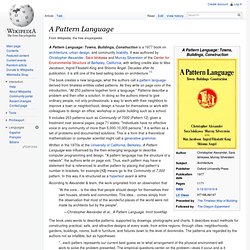
It was authored by Christopher Alexander, Sara Ishikawa and Murray Silverstein of the Center for Environmental Structure of Berkeley, California, with writing credits also to Max Jacobson, Ingrid Fiksdahl-King and Shlomo Angel. Decades after its publication, it is still one of the best-selling books on architecture.[1] TO UNDERSTAND IS TO PERCEIVE PATTERNS. Liberating Voices Pattern Language. Liberating Voices. "If we keep following the well-trodden paths that have brought us to where we are, we'll never get to where we want to go.
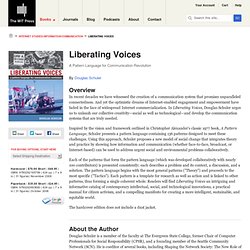
Schuler and his colleagues believe that we can get out of these ruts, and better yet, they tell us how. This work goes beyond elections and demonstrations, beyond cynicism and business as usual. It asks the much deeper questions: what kind of a world do we want and what must we do to get there? Schuler and his colleagues show us that another world is possible and invite everybody to the project. I say, 'Let's get going.'" "In this wide-ranging analysis of the role of information in society, Doug Schuler proposes a grand theory that weaves together disparate information and communication activities into an organized, synergistic fabric.
Pattern Language.com. A Pattern Language for Living Communication. This article was published in the proceedings of PDC '02, Participatory Design Conference; Malmo, Sweden.
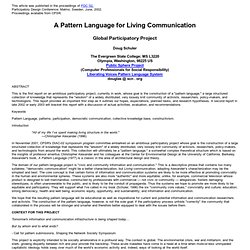
June, 2002. Proceedings available from CPSR. Doug Schuler The Evergreen State College; MS L3220 Olympia, Washington, 98225 USPublic Sphere Project (Computer Professionals for Social Responsibility)Liberating Voices Pattern Language System douglas @ scn . org. Welcome to the Pattern Language Project. You can now add information using the Pattern Language Development Data Sheet (Note that you'll need to open a Drupal account — and that the information isn't integrated yet into the rest of the site.)
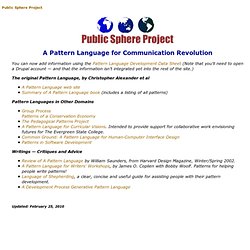
The original Pattern Language, by Christopher Alexander et al. In Quest of a Strategic Pattern Language: a new architecture of values. 11th October 2008 | Draft a new architecture of values Poster prepared for a Panel on Ethics and Policies for Sustainable Futures (Hyderabad, 2008) of the World Academy of Art and Science.
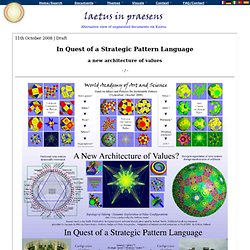
Commentaries in Topology of Valuing: psychodynamics of collective engagement with polyhedral value configurations (2008) and Towards Polyhedral Global Governance: complexifying oversimplistic strategic metaphors (2008). Poster image may also be separately printed in A2 format (42x59cm) of higher quality [10MB; 20MB]. The page, with the following commentatry, may also be printed in PDF format. Commentary 1. 2. 3. 4. 5. 6. 7. 8. 9. 10. Forest Gardening: Vision & Pattern Language « Regenerative Designs. We’re in the middle of the Design & Theory weekend of the 2010 Forest Garden Immersion Series.
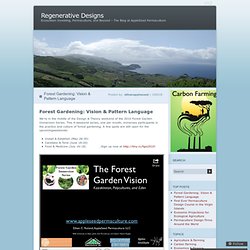
This 4-weekend series, one per month, immerses participants in the practice and culture of forest gardening. A few spots are still open for the upcomingweekends: Install & Establish (May 28-30)Caretake & Tend (June 18-20)Food & Medicine (July 16-18) …Sign up now at We’re compressing the entire Edible Forest Gardens design process (EFG Volume II, Chapter 3 & 4) articulated by Dave Jacke and Eric Toensmeier into a single weekend – so our teaching team needed to get creative. Pattern Language 3.0. Recently, I'm thinking about the methodological evolution of pattern languages, which is a method to describe design knowledge in a certain domain from the viewpoint of problem finding and problem solving (Alexander, 1979).
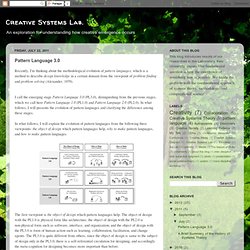
I call the emerging stage Pattern Language 3.0 (PL3.0), distinguishing from the previous stages, which we call here Pattern Language 1.0 (PL1.0) and Pattern Language 2.0 (PL2.0). In what follows, I will presents the evolution of pattern languages and clarifying the difference among these stages. In what follows, I will explain the evolution of pattern languages from the following three viewpoints: the object of design which pattern languages help, why to make pattern languages, and how to make pattern languages. The first viewpoint is the object of design which pattern languages help. The second viewpoint is why to make pattern languages. The third viewpoint is why to make pattern languages. Hcipatterns.org : hcipatterns.org. PmWiki : PLE Pattern Language. To develop the reference model for the PLE in general, and for the instruments provided by the PersonalLearningToolkit in particular, we used a pattern language approach.
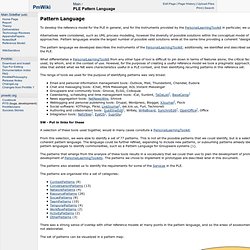
Alternatives were considered, such as UML process modelling, however the diversity of possible solutions within the conceptual model of a PLE are too diverse for most UML-based approaches. Pattern languages enable the largest number of possible valid solutions while at the same time providing a coherent "design vocabulary". The pattern language we developed describes the instruments of the PersonalLearningToolkit; additionally, we identified and described services needed from the ServiceProviders in the PLE. What differentiates a PersonalLearningToolkit from any other type of tool is difficult to pin down in terms of features alone; the critical factors are primarily in how the system is used, by whom, and in the context of use.
Blog of Collective Intelligence: Pattern Language Archives. Building a research-based, dynamic knowledge repository of social media strategies Writing about what she was up to four years ago, Joanne Jacobs noted: “the impact of social media was so poorly understood that the opportunity to develop a sophisticated (and academically rigorous) methodology for assessing social media strategies was too difficult.
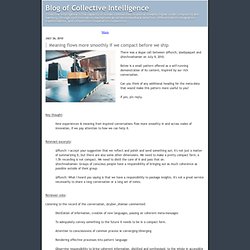
We are now, however, at a stage where such a document could be collaboratively produced.” Yes, we are, or at least, it is my working hypothesis #1 worth verifying. “Social media strategies” can also serve as an important context for a much needed action enquiry into how to let practices worth replicating (PWR) spread faster and farther. Assessing the fitness of rapidly evolving strategies on any domain can be a high-value contribution to the collective intelligence of that domain, particularly, if it was supported by a “sophisticated (and academically rigorous) methodology,” as Joanne noted. Welcome to the Group Pattern Language Project. Home - Pattern Language of Group Process. "pattern language" Tips For Writing Pattern Languages. This is a message originally sent by WardCunningham to the PatternsList in January 1994.

I can't find it archived online anywhere. SteveBerczuk sent me an OCR'ed version he had, which I just cut and pasted in. -- DougLea Friends - I'd like to encourage all of you to get your pattern pencils out and get to work on your submissions to the PLoP'94 conference. To that end, let me suggest a few steps that have helped me get something down on paper. Also, I've included the introduction and section headings from what I expect to be my own submission: a pattern language I call CHECKS. But first the steps... 1) Pick a whole area, not just one idea. Pattern language. A pattern language is a method of describing good design practices within a field of expertise. The term was coined by architect Christopher Alexander and popularized by his book A Pattern Language.
Advocates of this design approach claim that ordinary people can use it to successfully solve very large, complex design problems. Design Patterns Catalog.